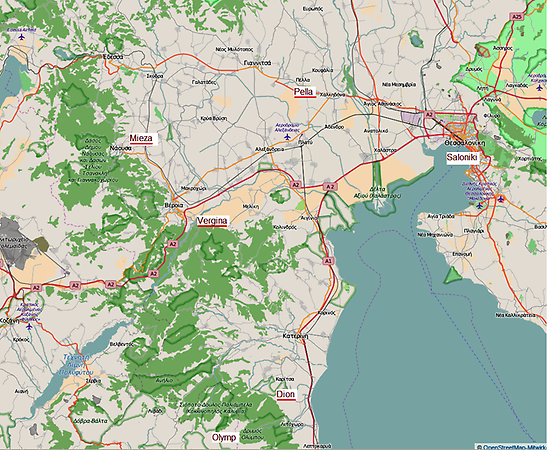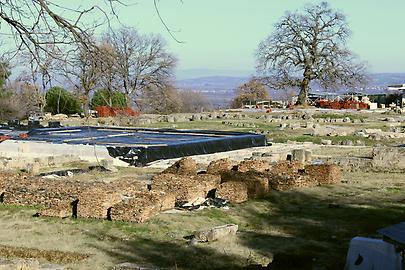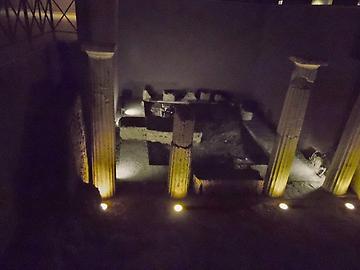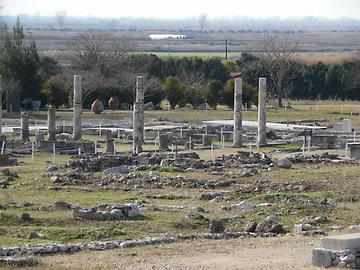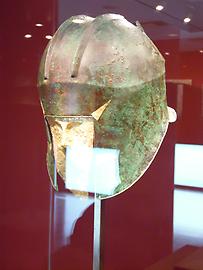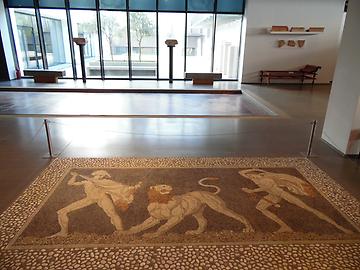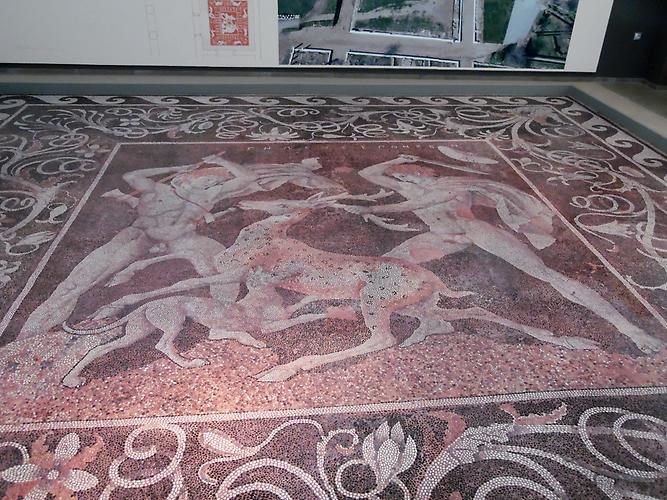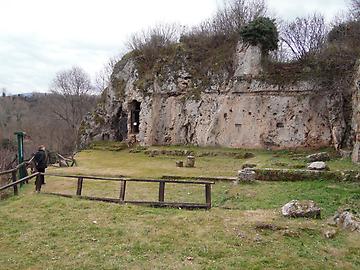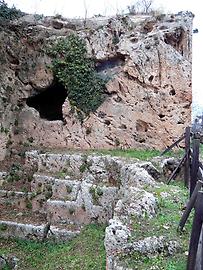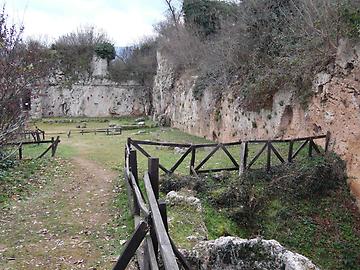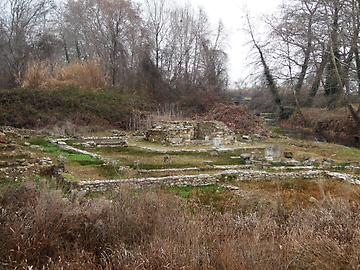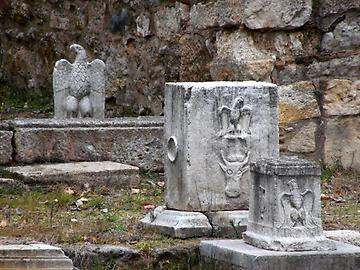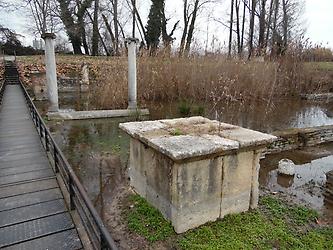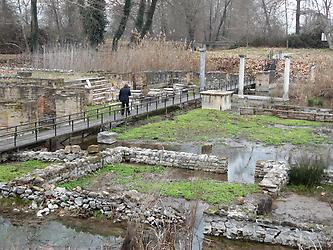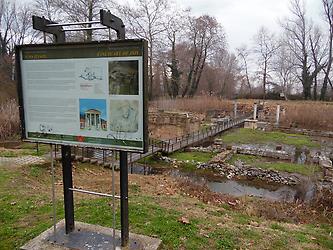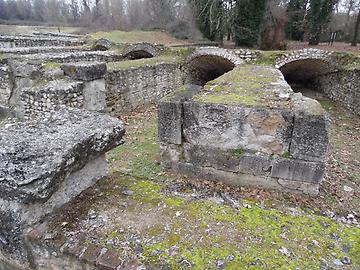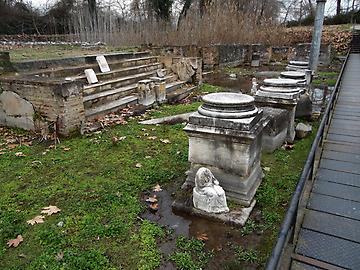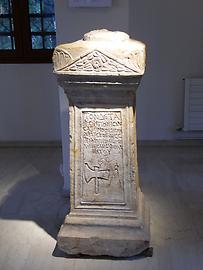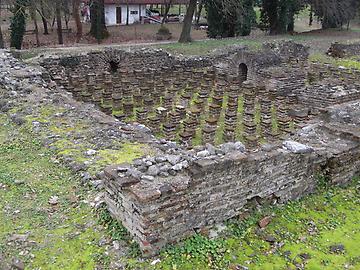Four Archaeological Sites in Northern Greece#
by Peter DiemVergina (Aigai)#
The archeological site of Aigai, the "place with many goats", is situated on the foothills of the "Macedonian mountain" (Pieria) about 50 km south-west of Thessaloniki. Though only a small part of the site has been excavated (ca. 1% of the cemetery, 0.20% of the city), its splendid finds have justly given Aigai a place among the monuments of the World Cultural Heritage. The ancient city of Aigai was the capital of Macedonia until 410 BC. It played a dominant role in the region from as early as the I0th-8th century BC, as its impressive tumuli cemetery demonstrates. Aigai was a city of "scattered villages", an agglomeration of loosely connected settlements that developed organically around a central core without a strict, predetermined plan; it was aligned with the royal presence, the relationship with the divine, and the need for imposing authority and ensuring defense: the palace, the sanctuaries, and the fortified acropolis. Thre burial clusters have been found to date: that of the Temenids, that of the queens, and that of Philip II. Aigai's necropolis reminds of Homer. Like Patroclus, the deceased Temenids were cremated together with rich gift offerings on magnificent pyres, a custom which reached its apogee with the burial of Philip II, while the queens of Aigai descended to Hades wrapped in gold and purple like the Mycenaeans.The ascent to the throne by Philip II (359-336 BC) marked Macedonia’s and Aigai's finest hour. Extremely intelligent, a superb general, a uniquely skilled diplomat and at the same time a Pythagorean initiate, Philip, an "enlightened despot" in accordance with the Platonic model, gathered round him the elite of the intelligentsia, which resulted in his court becoming a matrix of cultural development as the Athens of Pericles had once been. The king decided to embellish the city, embarking on a building program without precedent. The walls were rebuilt so as to ensure the city's safety, and simultaneously to lend it prestige and grandeur; the sanctuaries of the gods acquired new temples, altars, and stoas. The rich finds from the archaic cemetery (7th-5th c. BC) testify to the city's prosperity. Ideas and goods flowed into Aigai continuously from the islands and the Ionian cities, from Corinth and Athens, while local production, chiefly distinguished in metal-working, was characterized by an austerity and geometric simplicity that reflected the Dorian origins of the Macedonians. During the reign of Alexander I (498-454 BC), Aigai became the center of the most important Greek state in the north, and life took on an unprecedented luxury. The new palace - the largest building Greece had yet seen - was built at a prominent site with the theater beside it. Power joined forces with art, and the perception that stamped the image of the large cities of the Hellenistic world was inaugurated at Aigai.
The treasures from the royal tombs give us a sense of the splendor of the city during its heyday. The frescos reveal the achievements of painting, which could recreate the world in a convincing way. The fascinating moment of the birth of realistic portraiture is reflected on Philip's gold and ivory couch. In vases, weapons, and jewelry, simplicity and clarity of form mingle with a delight in detail, creating an assemblage of incomparable elegance and harmony where everything is subjected to the charm of the rule. As king of Macedon, ruler of the Balkans and elected leader of all the Greeks, in 336 BC Philip II engaged upon the greatest celebration of his reign. In the theater of Aigai the assassin's dagger struck him down at his moment of glory. The history of the world was changed but Aigai passed to the margins of history. Following the fate of the kingdom of Macedon, after the defeat by the Romans in 168 BC, it was destroyed, fell into decline, and was forgotten until the excavations of Manolis Andronikos in 1977 gave back to the place its name and the history of Macedonia began to be rewritten...
The Vergina Museum#
The museum was built into the Great Tumulus. The darkness that reigns in the space arouses awe and turns voices into whispers, suggesting the atmosphere in the land of the dead. The first unit of the museum is devoted to the Macedonians whose grave stones were found in the fill of the Great Tumulus. Immediately following these are the ruins of the Macedonian tomb with its free-standing columns, a monument built in the Early Hellenistic age on the edge of the royal tumulus. One can see the king's weapons, the utensils employed in his funeral ceremony, the symbols of his authority and the precious bronze household utensils employed for his final bath. Immediately afterward one may descend the "dromos" of Philip's tomb and admire the fresco with the royal hunt, a work with nothing to envy the creations of the great Renaissance masters. Also shown are the remains of the funerary pyre that were found thrown on the vault of the tomb, irrefutable evidence of the deceased's identity. The heart of the exhibition is devoted to Philip II. Here, among the gold chests and wreaths, the splendid symposium utensils and the precious gold and ivory banquet couches, stands as a trophy to memory: his "resurrected" gold-trimmed armor.Pella#
The capital of the Macedonian kingdom was moved from Aigai to Pella in the late 5th century BC, for it ensured better communication with the rest of the Greek world, by sea routes and by plain. Its oldest residential remains indicate the presence of a city plan with rectangular building blocks from the first half of the 4th century BC. In the second half of the 4th century BC, the growth of local pottery, terracotta, metalworking and mosaic floor workshops laid the basis for a flourishing production that continued until the city was abandoned following the earthquake that struck it in the early 1st century BC. The ancient city extended over an area of about 400 hectares. Its lay-out, with rectangular building blocks of equal width uniformly separated by roads between 6 and 9 m wide, is impressive, as it is the most fully-developed seen in an ancient city of the Greek world; to have an idea of its size, it stretched over an area extending 2.5 km North-South, and about 1.5 km East-West. Some of its main roads were wider than others, and were paved and surrounded by sidewalks and colonnades, while beneath their roadbeds lay dense, well-organized water and drainage networks. Rock-hewn tunnels carried water down from mountain springs; these ended in clay, stone, or built pipes with manholes so that they could be cleaned. These, together with fountains, wells, and cisterns in public and private buildings, all testify to the high standard of living enjoyed by residents. Areas for bathing have been found in many houses as well as in public structures. In one public bath near the site's new entrance, all the evolutionary phases of bathing installations in Greece are shown, including one of the earliest forms of underground heating. Private residences with central peristyle courtyards featuring Doric and Ionic architectural elements, banquet-rooms with floors elaborately decorated in natural mosaic tesserae, wall paintings with renderings of architectural elements that were later widely adopted in Italian cities (e.g. Pompeii, which gave its name to this particular style of decoration), small household shrines, the private apartments, ancillary and hygiene spaces all suggest an economically and culturally-flourishing society. The palace of Pella occupied an area of 60,000 sq. m, and was comprised of five building units with large peristyle courtyards, reception rooms, meeting rooms, spaces for worship, private apartments complete with baths, workshops, and storerooms, as well as bathing installations incorporated into a large palaestra. In the heart of the city was the Agora, its large commercial and administrative center, which encompassed an area of 70,000 sq. m. The square's center was bisected along its East-West axis by the city's largest street, 15 m in width. In the Agora there were organized workshops for making pottery, terracotta figurines, and metal objects, shops for selling the objects produced, as well as shops selling food, grain, and meat, in addition to wine from many regions; there were even perfume shops.The Pella Museum#
The first thematic grouping of the main exhibition area concerns the daily life of Pella's inhabitants. A reconstruction of a wooden door indicates the entrance to this exhibit. The main objects on display here are the mosaic floors from the Houses of Dionysus and of the Abduction of Helen, set in the floor, and the wall decoration from the so-called House of the Wall Plasters, restored in polychrome plaster. The exhibit cases display excavation finds that provide a wealth of information about the structure and functions of the rooms in residences, their furnishings, the daily life of their residents, their clothing, personal adornment, occupations, rituals at household shrines, exercise, education, and amusements. The second thematic grouping has public life in Pella as its theme. The finds on display come primarily from the Agora and are connected with administrative institutions. The exhibit's third thematic grouping displays mosaic floors and finds from Pella's sanctuaries, with information about the gods worshipped there and the organization and function of religious buildings (the sanctuaries of Darron, the Mother of the Gods and Aphrodite, the Thesmophorion). A variety of votive objects (terracotta figurines, marble statuettes, inscriptions, vases, and metal objects) suggest the various activities of the organized sanctuaries in Pella. The fourth thematic exhibit, on the city's cemeteries, is the only one isolated from the others by virtue of the particular nature of grave goods. From the balcony surrounding the exhibit space on the main floor, there is the opportunity for a panoramic view of the exhibits.The Nympheon of Mieza#
The ruins of Aristotle's School are situated only 2 kilometers away from the contemporary city of Naoussa. Here is the place with the racing water and the shaded caves, mentioned by the ancient writers, where the greatest philosopher of antiquity taught classical Greek thought and the ideals of the Platonic philosophy to the kings of Macedonia, Phillip II, his son Alexander and the other nobles of the Macedonian court.
The Nympheon, a sanctuary dedicated to the Nymphs, lies in a largely untouched natural landscape. The ancient remnants - a wall prop of a two-floored arcade with Ionic columns combined with three natural caves - constitute the main grounds of the School. The vertical surface of the rock, where the openings for supporting the roof's girders are discernable, comprised the back-end of the shady stoa (built at 350 B.C. and later), where Aristotle taught «the doctrines of morals and politics" (Plutarch VII, 668) to the youths of the Macedonian nobility. Aristotle and his students slept, cooked and studied in caves. They extracted an austere yet enlightening existence from divine wilderness. They also studied applied skills, such as hunting, wrestling and combat.
Alexander and his colleagues attended the school for two years. Here, in the shady covered walks and on the stone seats mentioned by Plutarch, the future world ruler was initiated into philosophy and poetry, mathematics and the natural sciences; and we know that he carried with him a copy of the Iliad which Aristotle had given him with a handwritten dedication. In 340 BC, the sixteen-year-old student left the school and returned to Pella in order to act as regent while his father was away in Perinthos and Byzantion. However, there are also doubts about the whole story rearding Aristotle and Alexander.
The Sanctuary of Dion#
The ancient city lies on the Western foothills of Mount Olympus, a few kilometers south of Katerini. It owes its name to the most important Macedonian sanctuary dedicated to Zeus (Dios, "or Zeus"), leader of the gods who dwelt on Mount Olympus; Hence from very ancient times, a large altar had been set up for the worship of Olympian Zeus and his daughters, the Muses, in an environment rich in vegetation, towering trees, countless springs and a navigable river. Dion was the "sacred place" of the Ancient Macedonians. It was the place where the kings made splendid sacrifices to celebrate the new year of the Macedonian calendar at the end of September. In the Spring, purification rites of the army and victory feasts were held. Philip II and Alexander the Great celebrated victories here, and Alexander assembled his armies and performed magnificent sacrifices here on the eve of his campaign to Asia in 334 BC. A city had been built adjacent to the sacred sites that acquired monumental form during the reigns of Alexander the Great's successors. Cassander took a great interest in the city erecting strong walls and public buildings, so that in Hellenistic times Dion was renowned for its fortification and splendid monuments. The streets were paved and there were large baths with an intricate watering and heating system.Sources: Local inscriptions and folders
Photographs: by P. Diem except where otherwise mentioned
